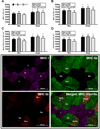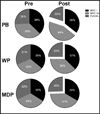Protein Supplementation Does Not Affect Myogenic Adaptations to Resistance Training - PubMed (original) (raw)
Randomized Controlled Trial
Protein Supplementation Does Not Affect Myogenic Adaptations to Resistance Training
Paul T Reidy et al. Med Sci Sports Exerc. 2017 Jun.
Abstract
It has been proposed that protein supplementation during resistance exercise training enhances muscle hypertrophy. The degree of hypertrophy during training is controlled in part through the activation of satellite cells and myonuclear accretion.
Purpose: This study aimed to determine the efficacy of protein supplementation (and the type of protein) during traditional resistance training on myofiber cross-sectional area, satellite cell content, and myonuclear addition.
Methods: Healthy young men participated in supervised whole-body progressive resistance training 3 d·wk for 12 wk. Participants were randomized to one of three groups ingesting a daily 22-g macronutrient dose of soy-dairy protein blend (PB, n = 22), whey protein isolate (WP, n = 15), or an isocaloric maltodextrin placebo (MDP, n = 17). Lean mass, vastus lateralis myofiber-type-specific cross-sectional area, satellite cell content, and myonuclear addition were assessed before and after resistance training.
Results: PB and the pooled protein treatments (PB + WP = PRO) exhibited a greater whole-body lean mass %change compared with MDP (P = 0.057 for PB) and (P = 0.050 for PRO), respectively. All treatments demonstrated similar leg muscle hypertrophy and vastus lateralis myofiber-type-specific cross-sectional area (P < 0.05). Increases in myosin heavy chain I and II myofiber satellite cell content and myonuclei content were also detected after exercise training (P < 0.05).
Conclusion: Protein supplementation during resistance training has a modest effect on whole-body lean mass as compared with exercise training without protein supplementation, and there was no effect on any outcome between protein supplement types (blend vs whey). However, protein supplementation did not enhance resistance exercise-induced increases in myofiber hypertrophy, satellite cell content, or myonuclear addition in young healthy men. We propose that as long as protein intake is adequate during muscle overload, the adaptations in muscle growth and function will not be influenced by protein supplementation.
Trial registration: ClinicalTrials.gov NCT01749189.
Conflict of interest statement
Conflicts of Interest
PTR, MSB, RRD, SI, MBC, RM, KJ, EV, BBR have no conflicts of interest.
The authors declare that this study was funded by Dupont Nutrition & Health. Representatives from Dupont Nutrition & Health were not involved with data collection and laboratory analysis
The results of the study are presented clearly, honestly, and without fabrication, falsification, or inappropriate data manipulation. The results of the present study do not constitute endorsement by ACSM.
Figures
Figure 1
Fiber-type specific and mean (MFA) vastus lateralis cross-sectional area by treatment. Protein blend (PB) or whey protein (WP) or maltodextrin placebo (MDP) and representative immunohistochemical image for identification of fiber typing and cross-sectional area quantification in vastus lateralis. MHC I stained purple (top left), MHC IIa stained green (top right), and MHC type IIx stained red (bottom right) and merged image (bottom left).Data are mean ± SEM, n=15 (WP), 22 (PB) & 17 (MDP). Units are µm2. Significant change * (p<0.05).
Figure 2
Vastus lateralis fiber-type specific satellite cell content, myonuclei and myonuclear domain by treatment and representative immunohistochemical image for fiber-type specific identification of Pax7 positive satellite cells and myonuclei. DAPI positive nuclei stained blue (top left), Pax7+ cells stained yellow (top right), laminin basement membrane stained red (middle left), MHC I stained purple and MHC II black - negative staining (middle right) and merged image with arrows highlighting Pax7+ satellite cells (bottom). Protein blend (PB), whey protein (WP) or maltodextrin placebo (MDP). Data are mean ± SEM, n=15 (WP), 22 (PB), 17 (MDP) & 37 (PRO). Units are µ2/myonucleus. * (p<0.05), # (p<0.10) vs pre within that group, main effect of exercise is denoted as a bar across both treatments. PRO (p<0.05) for change in pooled protein group vs pre. PRO > MDP & (p=0.073) via ANCOVA.
Figure 3
Myosin heavy chain composition (MHC) in the vastus lateralis expressed as relative frequency. PRO indicates an effect of the pooled protein treatments to increase over pre. Significant change vs. pre * (p<0.05). Bar indicates an exercise effect.
Similar articles
- Protein Supplementation Has Minimal Effects on Muscle Adaptations during Resistance Exercise Training in Young Men: A Double-Blind Randomized Clinical Trial.
Reidy PT, Borack MS, Markofski MM, Dickinson JM, Deer RR, Husaini SH, Walker DK, Igbinigie S, Robertson SM, Cope MB, Mukherjea R, Hall-Porter JM, Jennings K, Volpi E, Rasmussen BB. Reidy PT, et al. J Nutr. 2016 Sep;146(9):1660-9. doi: 10.3945/jn.116.231803. Epub 2016 Jul 27. J Nutr. 2016. PMID: 27466602 Free PMC article. Clinical Trial. - Protein Supplementation Augments Muscle Fiber Hypertrophy but Does Not Modulate Satellite Cell Content During Prolonged Resistance-Type Exercise Training in Frail Elderly.
Dirks ML, Tieland M, Verdijk LB, Losen M, Nilwik R, Mensink M, de Groot LCPGM, van Loon LJC. Dirks ML, et al. J Am Med Dir Assoc. 2017 Jul 1;18(7):608-615. doi: 10.1016/j.jamda.2017.02.006. Epub 2017 Apr 1. J Am Med Dir Assoc. 2017. PMID: 28377156 Clinical Trial. - Effects of Whey, Soy or Leucine Supplementation with 12 Weeks of Resistance Training on Strength, Body Composition, and Skeletal Muscle and Adipose Tissue Histological Attributes in College-Aged Males.
Mobley CB, Haun CT, Roberson PA, Mumford PW, Romero MA, Kephart WC, Anderson RG, Vann CG, Osburn SC, Pledge CD, Martin JS, Young KC, Goodlett MD, Pascoe DD, Lockwood CM, Roberts MD. Mobley CB, et al. Nutrients. 2017 Sep 4;9(9):972. doi: 10.3390/nu9090972. Nutrients. 2017. PMID: 28869573 Free PMC article. Clinical Trial. - Protein supplementation augments the adaptive response of skeletal muscle to resistance-type exercise training: a meta-analysis.
Cermak NM, Res PT, de Groot LC, Saris WH, van Loon LJ. Cermak NM, et al. Am J Clin Nutr. 2012 Dec;96(6):1454-64. doi: 10.3945/ajcn.112.037556. Epub 2012 Nov 7. Am J Clin Nutr. 2012. PMID: 23134885 Review. - Protein Availability and Satellite Cell Dynamics in Skeletal Muscle.
Shamim B, Hawley JA, Camera DM. Shamim B, et al. Sports Med. 2018 Jun;48(6):1329-1343. doi: 10.1007/s40279-018-0883-7. Sports Med. 2018. PMID: 29557519 Review.
Cited by
- Plant-Based Proteins, Peptides and Amino Acids in Food Products Dedicated for Sportspeople-A Narrative Review of the Literature.
Kostrakiewicz-Gierałt K. Kostrakiewicz-Gierałt K. Nutrients. 2024 May 30;16(11):1706. doi: 10.3390/nu16111706. Nutrients. 2024. PMID: 38892638 Free PMC article. Review. - Effects of resistance training and protein supplementation interventions on muscle volume and muscle function: sex differences in humans.
Noh KW, Park S. Noh KW, et al. Phys Act Nutr. 2023 Dec;27(4):15-25. doi: 10.20463/pan.2023.0033. Epub 2023 Dec 31. Phys Act Nutr. 2023. PMID: 38297472 Free PMC article. - Effect of Soy Protein Supplementation on Muscle Adaptations, Metabolic and Antioxidant Status, Hormonal Response, and Exercise Performance of Active Individuals and Athletes: A Systematic Review of Randomised Controlled Trials.
Zare R, Devrim-Lanpir A, Guazzotti S, Ali Redha A, Prokopidis K, Spadaccini D, Cannataro R, Cione E, Henselmans M, Aragon AA. Zare R, et al. Sports Med. 2023 Dec;53(12):2417-2446. doi: 10.1007/s40279-023-01899-w. Epub 2023 Aug 21. Sports Med. 2023. PMID: 37603200 Free PMC article. - Mechanisms of mechanical overload-induced skeletal muscle hypertrophy: current understanding and future directions.
Roberts MD, McCarthy JJ, Hornberger TA, Phillips SM, Mackey AL, Nader GA, Boppart MD, Kavazis AN, Reidy PT, Ogasawara R, Libardi CA, Ugrinowitsch C, Booth FW, Esser KA. Roberts MD, et al. Physiol Rev. 2023 Oct 1;103(4):2679-2757. doi: 10.1152/physrev.00039.2022. Epub 2023 Jun 29. Physiol Rev. 2023. PMID: 37382939 Free PMC article. Review. - Nutritional Regulation of Muscle Stem Cells in Exercise and Disease: The Role of Protein and Amino Acid Dietary Supplementation.
Beaudry KM, Binet ER, Collao N, De Lisio M. Beaudry KM, et al. Front Physiol. 2022 Jul 7;13:915390. doi: 10.3389/fphys.2022.915390. eCollection 2022. Front Physiol. 2022. PMID: 35874517 Free PMC article. Review.
References
- Alway SE, Pereira SL, Edens NK, Hao Y, Bennett BT. beta-Hydroxy-beta-methylbutyrate (HMB) enhances the proliferation of satellite cells in fast muscles of aged rats during recovery from disuse atrophy. Exp Gerontol. 2013;48(9):973–984. - PubMed
- Andersen LL, Tufekovic G, Zebis MK, et al. The effect of resistance training combined with timed ingestion of protein on muscle fiber size and muscle strength. Metabolism. 2005;54(2):151–156. - PubMed
- Babault N, Deley G, Le Ruyet P, Morgan F, Allaert FA. Effects of soluble milk protein or casein supplementation on muscle fatigue following resistance training program: a randomized, double-blind, and placebo-controlled study. Journal of the International Society of Sports Nutrition. 2014;11:36. - PMC - PubMed
Publication types
MeSH terms
Substances
Grants and funding
- T32 HD007539/HD/NICHD NIH HHS/United States
- UL1 TR000071/TR/NCATS NIH HHS/United States
- TL1 TR001440/TR/NCATS NIH HHS/United States
- R01 AR049877/AR/NIAMS NIH HHS/United States
- P30 AG024832/AG/NIA NIH HHS/United States
- UL1 TR001439/TR/NCATS NIH HHS/United States
LinkOut - more resources
Full Text Sources
Other Literature Sources
Medical


